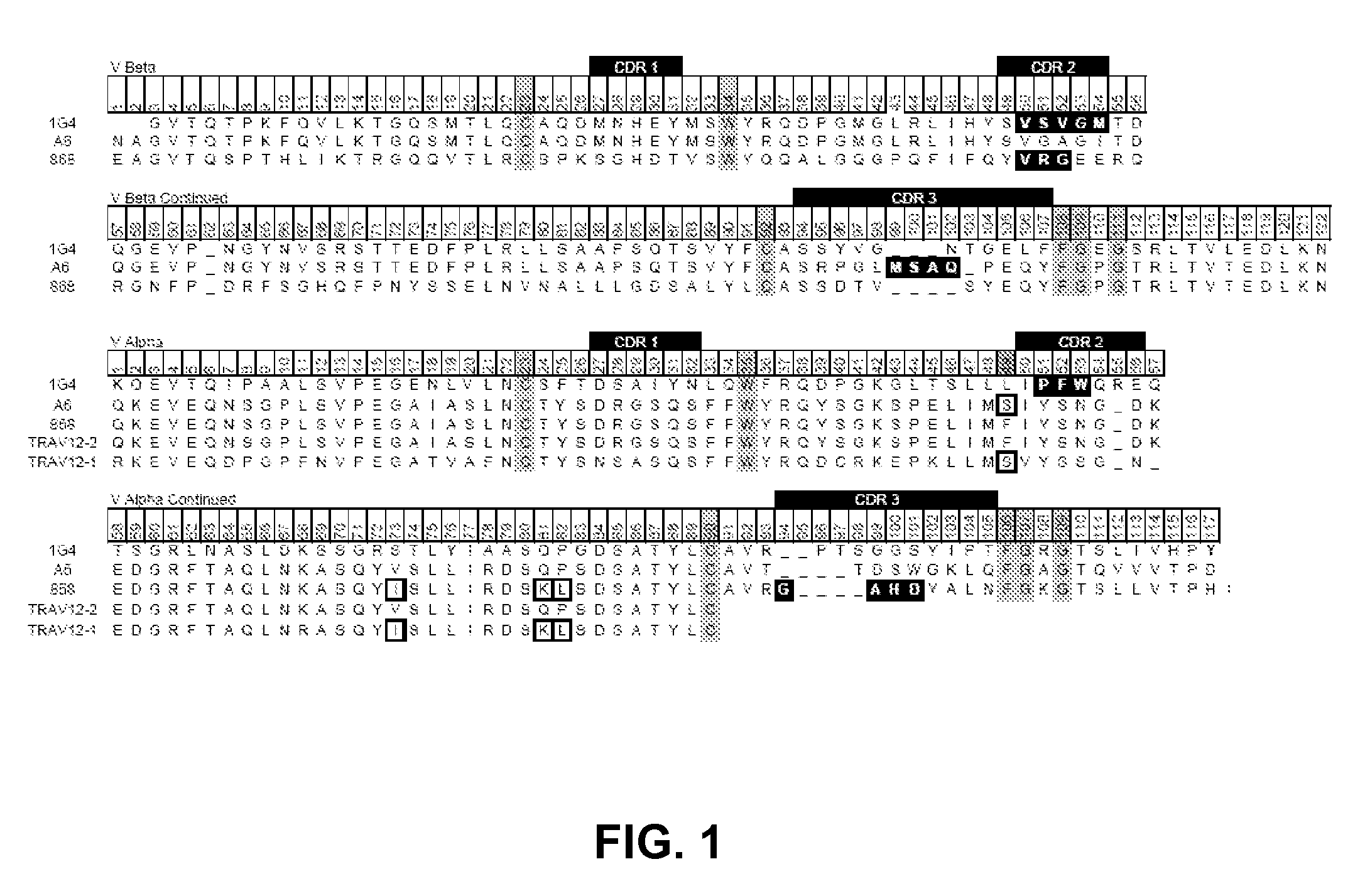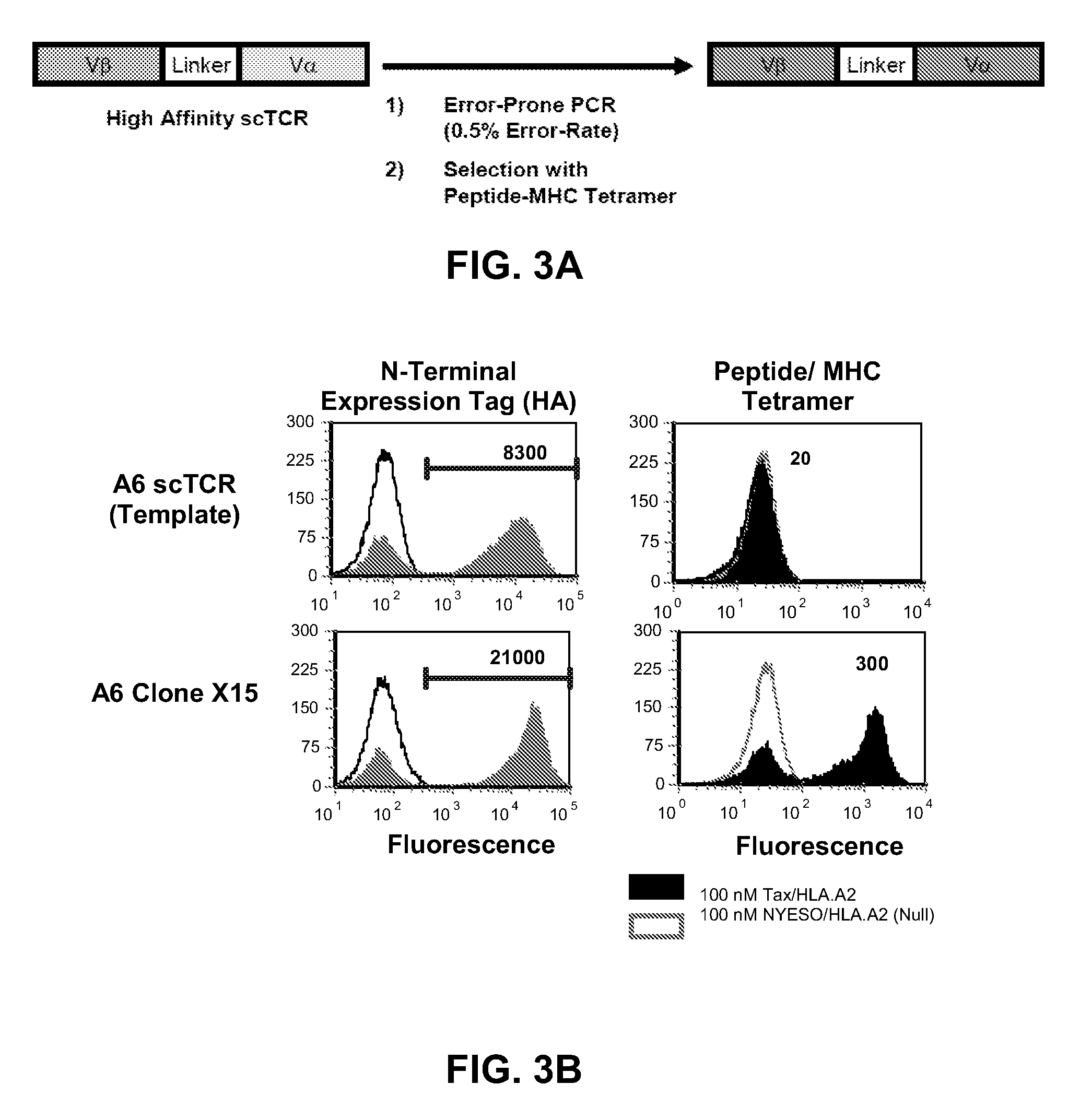Human Single-Chain T Cell Receptors
a t cell receptor and human single-chain technology, applied in the field of human single-chain t cell receptors, can solve the problems of unable to detect properly folded pep:mhc tetramers, and the inability to produce sufficient quantities for clinical or even pre-clinical use, and achieve the effect of higher affinity for a particular ligand
- Summary
- Abstract
- Description
- Claims
- Application Information
AI Technical Summary
Benefits of technology
Problems solved by technology
Method used
Image
Examples
example 1
Yeast Display of Human Single-Chain and Full-Length TCRs
[0092]Three human T cell receptors (1G4, A6, 868) that were previously engineered for improved affinity by phage display using a full-length display format were used for this study (7, 9, 19). The variable domains of these TCRs contain complementarity determining region (CDR) mutations that confer high affinity for specific pep:MHC (FIG. 1). The variants selected all have measured KD values reported to be at least 10 nM. TCRs specific for peptides derived from NYESO prostate tumor antigen (1G4 TCR), human T cell lymphotrophic virus tax protein (A6 TCR), and human immunodeficiency virus gag protein (868 TCR) were synthesized (Genscript) with the variable domains attached by a flexible linker (Vβ-linker-Vα) and high affinity mutations as described (Table 1). The majority of T cell receptor variable domains cannot be expressed in heterologous expression systems in the absence of constant domains, and consequently stabilizing mutat...
example 2
Engineering Surface Displayed scTCRs by Random Mutagenesis: TCR Against HTLV (Virus) Epitope
[0099]To determine whether A6 and 1G4 scTCR mutations would enable expression on yeast cells, and whether the 868 scTCR could be mutated to facilitate higher levels of expression on yeast cells, the 1G4, A6, and 868 scTCRs were subjected to rounds of random mutagenesis and subsequently sorted with pep:MHC tetramer to isolate variants with improved surface expression (FIG. 3A). Despite multiple rounds of mutagenesis and sorting of the NYESO specific TCR 1G4, no stabilized variants were isolated. In contrast, stabilized mutants of the HTLV specific A6 scTCR and HIV specific 868 TCR were isolated after mutagenesis and fluorescence activated cell sorting, as described individually below.
[0100]A6 scTCR: The HTLV Tax specific TCR A6 was sorted with Tax / HLA.A2 phycoerythrin tetramer to isolate variants that were expressed on the yeast surface. An error-prone PCR library was created across the entire...
example 3
Engineering Surface Displayed scTCRs by Random Mutagenesis: TCR Against HIV (Virus) Epitope
[0101]868 scTCR: For the HIV Gag (SL9 peptide) specific 868 scTCR, we sought to improve the surface levels of the yeast-displayed protein by random mutagenesis (error-prone PCR) and temperature stability sorting. After two rounds of selection with pep:MHC tetramer and an additional round of temperature selection, a temperature stable, scTCR mutant called 868-Z11 was isolated. The 868-Z11 mutant bound to SL9 / HLA.A2 PE tetramer at concentrations as low as 1 nM as detected by flow cytometry (FIG. 3C and data not shown). 868 Z11 also exhibited improved surface levels relative to the full-length 868 TCR expressed on the yeast cell surface (FIG. 5). This demonstrated that the single-chain format allows for higher surface levels of productively arranged Vβ-linker-Vα pairs relative to the full-length C region-containing format.
PUM
| Property | Measurement | Unit |
|---|---|---|
| Molar density | aaaaa | aaaaa |
| Molar density | aaaaa | aaaaa |
| Binding constant | aaaaa | aaaaa |
Abstract
Description
Claims
Application Information
 Login to View More
Login to View More - R&D
- Intellectual Property
- Life Sciences
- Materials
- Tech Scout
- Unparalleled Data Quality
- Higher Quality Content
- 60% Fewer Hallucinations
Browse by: Latest US Patents, China's latest patents, Technical Efficacy Thesaurus, Application Domain, Technology Topic, Popular Technical Reports.
© 2025 PatSnap. All rights reserved.Legal|Privacy policy|Modern Slavery Act Transparency Statement|Sitemap|About US| Contact US: help@patsnap.com



